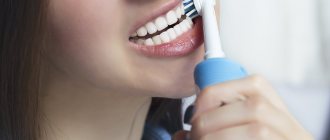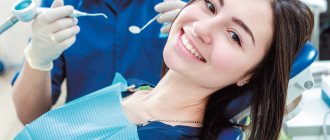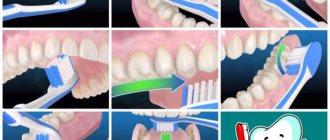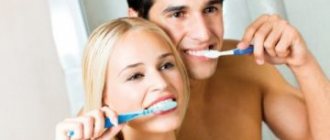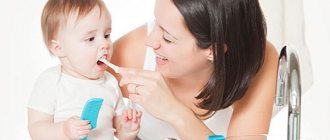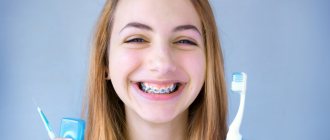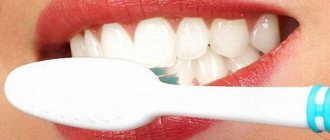In this article
- What types of electric brushes are there?
- Electric brushes: indications for use
- Electric toothbrushes: contraindications
- Advantages of electric brushes
- Cons of electric toothbrushes
- Can an electric toothbrush harm your teeth?
- How to choose an electric toothbrush
An electric toothbrush allows you to maintain better oral hygiene than a regular toothbrush. Both scientists and dentists talk about this. With its help, you can effectively clean your teeth, rid them of plaque and prevent the formation of tartar. Not all people know about the benefits of such brushes. Let's take a closer look at their advantages and disadvantages.
An electric toothbrush is a device consisting of a handle with a battery, a body with a motor, and a head with bristles. The device converts current into high frequency vibrations, causing the bristles to vibrate automatically up and down or in a circle. Teeth cleansing occurs due to vibration itself, friction and flow of water, saliva and paste, formed by the oscillatory movements of the brush. Thanks to this, the oral cavity is thoroughly cleaned of food debris, deposits and plaque.
According to experts, even an inexpensive electric brush allows you to better maintain oral hygiene than any manual brush. To complete the picture, we list both the advantages and disadvantages of such devices.
Characteristics of electric brushes
Electric toothbrushes, first released in the 60s of the last century, are popular among dental care methods. Electric toothbrushes provide automatic vibration with a large number of movements per second, which a person is not able to repeat. Thanks to automatic movements, caring for teeth is easy and children also find it interesting.
Modern types of electric brushes differ favorably in many respects from their first analogues. The main characteristics of various models include:
- Soft pulsation of reciprocating movements;
- Several cleaning speeds, for example, lower for sensitive areas of gums and teeth;
- The great benefit of an electric toothbrush is its ergonomic shape, which makes cleaning easy for users of all ages;
- Partially reconfigurable for maneuverability and increased stability in the mouth;
- Provided change of nozzles;
- Reliable battery with charging indication.
Is pressing required?
The cleaning process does not require special pressure, as this is harmful to the enamel. Even low power attachments operate at 4000 rpm. You just need to turn on the required mode: maximum or gentle cleaning.
Some modern models have sensors that control the pressure applied, as well as a timer that shows the time required to clean a segment of the dentition. Electronic “smart” devices are very convenient to use, but they are also expensive: the cost starts from 7-10 thousand rubles.
Benefits of electric toothbrushes
Dentists recommend the use of electric toothbrushes, since thanks to the active air-droplet flow, which is ensured by an increased rotation speed, the teeth of all patients, including children, can be gently cleaned, and dentures can be cleaned without damage. In addition, disabled people, as well as people who have problems with the motor system or do not have sufficient skills to use small objects, will solve the important task of maintaining oral hygiene with the help of an electric brush. As a result of the benefits of an electric toothbrush : fast and high-quality teeth cleaning.
Another advantage of a toothbrush: tooth enamel is not damaged at all . The technology of the reciprocating rotational cleaning mechanism allows you to clean the interdental space while simultaneously naturally whitening the tooth surface. Modern models are characterized by additional functions, including, for example, the ability to brush your front teeth for 30 seconds using any of the available modes. The installed timer will allow you to complete the procedure in full, which is not always possible when cleaning yourself.
One of the distinctive advantages of using an electric brush is also the prevention of gingivitis due to the vibration effect on the gums. With constant use, frequent bleeding of the gums is eliminated.
Ultrasonic electric toothbrushes not only effectively clean plaque, but also destroy tartar and deep deposits. In combination with the use of dental floss, this allows you to maintain the health and beauty of your teeth and oral cavity, and as a result, the procedure for professional oral hygiene becomes optional.
To briefly describe the benefits of an electric toothbrush , it consists of the following advantages:
- High-quality teeth cleaning;
- Removal of dental deposits and tartar removal;
- Convenient and safe cleaning in the presence of braces or dentures;
- Prevention of gingivitis;
- Strengthening gums and improving their blood circulation;
- Convenient calculation of cleaning time thanks to the timer;
- Saving your own money on professional oral hygiene;
Among the expensive models, there are specimens that have a useful ultraviolet lamp for disinfection. Enabling this function allows you to independently disinfect the oral cavity, which provides a high level of protection against infection and the development of caries.
How to properly brush children's teeth?
A child can be introduced to an electric toothbrush from the age of 3 years. But up to 7, you should guide the brush and not let go of it while brushing. During this period, it is important to teach the child to spit the toothpaste and rinse his mouth.
The technique of brushing teeth in adults and children is no different - the only difference is that parents help children brush their teeth. Sit in a way that is comfortable for both of you: sit the child on your lap or stand behind him in front of the mirror. If your brush does not have a built-in two-minute timer, use a special application that will motivate and captivate the child (for example, some applications gradually open a picture of cartoon characters while brushing teeth).
Harm from using electric toothbrushes
The danger with electric toothbrushes is that if used incorrectly, they can cause significant damage to your teeth.
The main negative aspect of using an electric brush is the thinning of tooth enamel, especially if a person has demineralization or fluorosis. In this case, it is better to choose a brush with softer bristles.
Due to the high speed of rotation of the bristles, an electric toothbrush can also cause harm in case of healing of any wounds in the oral cavity after surgery or dental intervention. In addition, it can complicate the situation with infectious periodontitis.
You should also change the head on your electric toothbrush at least once every 3-4 months, as a large number of germs and bacteria accumulate on it, and the bristles of the brush wear out, so cleaning will be less efficient.
Teeth brushing technique
Brushing your teeth with an electric toothbrush is much easier than with a manual toothbrush because it does half the work for you. The bristles need to be moistened with water and a pea-sized amount of paste applied to it, as on a regular brush. Mentally divide your jaw into four sectors - each should take at least 30 seconds to cleanse.
And then the differences begin. There is no need to make sweeping movements - just move the brush smoothly from tooth to tooth.
If you have a brush with a round attachment , the bristles should cover one tooth completely from different sides. Clean the outer surface of the tooth first, then move to the inner surface and finish with chewing. Apply gentle pressure from above to clean between teeth. Pause on each tooth for 3-4 seconds.
If you have a brush with an oval attachment , place it at an angle of 45° to the surface of the teeth. The brush head should cover 2 teeth. Smoothly move it along the dentition, first on the outer, then on the inner and chewing surface.
The bristles should touch not only the teeth, but also the gums. Many brushes are equipped with a pressure sensor - if yours does not, be careful not to press too hard on the brush and injure your gums.
Recommendations for caring for an electric toothbrush
An electric toothbrush has very soft and delicate bristles, which easily become dirty and therefore require careful care. To ensure that the brush is always absolutely clean, dentists recommend that after use, rinse it under a strong stream of hot water and then soap it. The soap can be washed off after a while or just before cleaning.
The brush must be dry before it is placed in a special case or glass. It is strictly prohibited to store a wet brush in a closed case to avoid the development and proliferation of bacteria and, consequently, the subsequent use of an electric toothbrush .
Some models provide for replacing the head with bristles, but in any case, if the question arises: how often should you change a toothbrush, doctors at our medical center strongly advise replacing the brush or bristles more than once within three months. In new models, the bristles are designed to last from 1 to 12 months, but this does not mean that replacement must be made after a year. Make sure to promptly follow this recommendation for reasons of benefit and hygiene, especially since some expensive models provide a wear indicator that will indicate the need for replacement.
Choice
Before purchasing an electric toothbrush, it is advisable to visit your dentist. After examining the condition of your teeth, the doctor will help you decide which product to choose and how to use it.
When purchasing an electric toothbrush, you must rely on the following rules:
- It is advisable to buy devices with a bowl-shaped or round head.
- It is important to pay attention to the pressure indicator; this function will prevent strong pressure on the teeth and gums, which will protect against injury.
- When choosing this device, you need to pay attention that the kit includes replaceable attachments that need to be changed periodically.
- There are different attachments - for cleaning, whitening, sensitive gums, children's, for crowns or bridges. The greater their number, the more versatile the product.
- The timer helps to evenly brush the upper and lower rows of teeth and protects against strong or insufficient exposure to a specific area.
The benefits and harms of electric toothbrushes: summary
After analyzing the advantages and disadvantages of using an electric toothbrush, we can conclude that the benefits of using an electric toothbrush are much greater than the harm and any negative consequences. Despite the high cost, the benefits of an electric toothbrush are obvious - better teeth cleaning, ease of use and prevention of oral diseases.
The number of electric toothbrushes is impressive in terms of shape, useful functions, various levels of performance and protection of tooth enamel. In this regard, before purchasing an electric toothbrush, do not be lazy to consult with experienced dentists to find the most appropriate model for a particular user.
Contraindications for use
The use of electric brushes also has contraindications:
- The use of electric toothbrushes by children under three years of age is prohibited.
- The use of an ultrasonic toothbrush is not recommended for pregnant women and patients with pacemakers.
- Electric brushes should not be used by people who have dental crowns, dentures, or veneers installed. Strong vibration can disturb or break such structures. But modern ultrasonic toothbrushes with optimally selected operating modes will help cope with this problem and will not cause any damage.
- Friction contributes to the deterioration of tooth enamel in people with low density or a high degree of abrasion .
- In cases of periodontal diseases : gingivitis, periodontitis, chronic stomatitis. The weakening of tooth enamel is indicated by a disease called caries at the white spot stage, that is, there are areas with impaired mineralization. The friction of an electrical device can lead to complete abrasion of the enamel and tooth loss.
- In teeth with wedge-shaped defects , such defects also increase during the use of the electric mechanism. Therefore, it is better for persons with such disadvantages not to use these devices.
- If there are many fillings in the mouth, bleeding gums, patients after oral surgery . If teeth are highly mobile, if malignant or benign tumors occur in the mouth, or if there are other contraindications, it is prohibited to use an electric brush.
Operating principle
The removal of contaminants from the enamel (food residues, plaque, stone) of any brush is ensured by the vibration of the bristles.
In conventional models, the speed of movement of the villi depends on the intensity of human movements. Electric brushes work independently. The motor built into the handle provides high frequency (from 5,000 to more than 30,000 rotations per minute) and more effective teeth cleaning results. A special timer, internal or external, simplifies control over the duration of the procedure. Electric brushes have no medical contraindications - they are allowed to be used by children over three years of age and adults.
The brush consists of three main parts:
- replaceable head. One brush with different attachments can be used by several people.
- head holder.
- handle, which includes: motor, control unit, power source.
The electric brush runs on batteries or a rechargeable battery, so the kit necessarily includes a charger designed for a regular outlet. There are brushes that are powered from the mains. But such devices have not yet become widespread because they are characterized by low mobility: they operate within a limited radius.
Replaceable brush heads allow the whole family to use one brush
